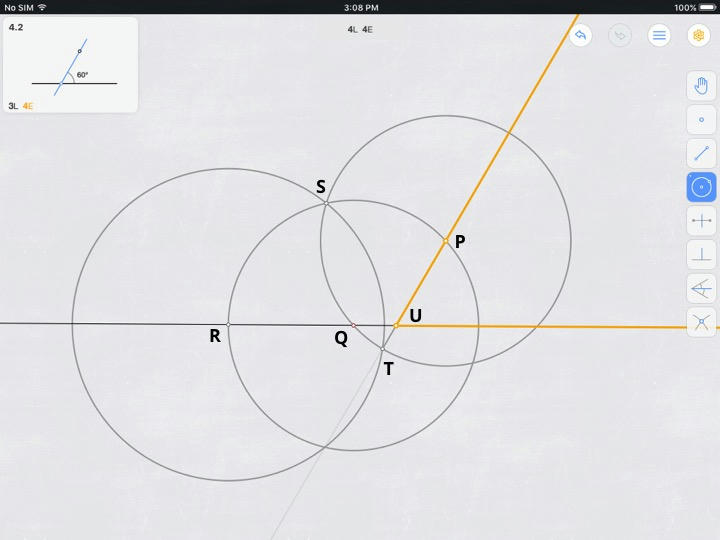I bet you know this game, Euclidea – if not I recommend it…
although I'm stuck on level 2.8 which is different on iOS than other platforms for which there are already walk throughs available.
Here is the riddle –
"Construct a straight line parallel to the given parallel lines that lies at equal distance from them"

I need to build using compass and ruler an equdistant line between two parallel lines (the equidistant will be parallel to those two). I did it, but there's an additional challenge to do it with 5 moves in this order-
Two circles and 3 lines. Obviously, it's possible to construct a perpendicular to the two parallel lines and then a perpendicular bisector for that one, but 5 steps is pretty tricky.
Is it even possible?! I'm breaking my head over this..
Good luck guys 🙂



Best Answer
SOLUTION Please refer to the figure below. Apologies for not having labels on this figure.
Construct two arbitrary points $O$ and $P$ on $b$ separated by a distance $OP > D$ (just eyeball it) [OE running total].
Construct circle $P(O)$ centered on point $P$ and with radius $OP$ [1E running total].
Construct $Q(O)$ [2E running total].
Construct $\overleftrightarrow{OL}$ [3E running total].
Construct $\overleftrightarrow{OR}$ [4E running total].
Construct the desired line $m = \overleftrightarrow{M_{L}M_{R}}$, shown in yellow in the figure below [5E final total].
PROOF OF THE SOLUTION
Given that $OP$ is chosen such that $OQ$ is larger than the gap $2D$ between the two give lines, there exist exactly two points $L$ and $R$ of intersection between $Q(O)$ and $a$.
Homothety is then used in this construction. First, we define a homothetic point ${O}$ on one of the lines, with $b$ used here without loss of generality. $Q(O)$ is constructed to have twice the radius of $P(O)$. Hence, taking $O$ as the homothetic point, also known as the center of dilation, we can view $P(O)$ as the half-fold 'dilation' of $Q(O)$. This means that every line through $O$ intersects $P(O)$ and $Q(O)$ at corresponding points, with the point on $P(O)$ half as far from $O$ as its corresponding point on $Q(O)$ is.
More specifically, the point $M_L$ on $P(O)$ that corresponds to the point $L$ on $P(O)$ can be found by intersecting $\overleftrightarrow{OL}$ and $P(O)$. Point $M_R$ can also be found analogously using $R$.
Homothety preserves parallelism. Therefore, line $m := \overleftrightarrow{M_LM_R}$ is parallel to both $a$ and $b$, as desired.
Given that the homothety involved here involves a half-fold dilation of $Q(O)$ to $P(O)$, we know that the gap between $a$ and $m$ is also half of the gap between $a$ and $b$. This is equivalent to saying that $m$ is equidistant from both $a$ and $b$, as desired. $\blacksquare$